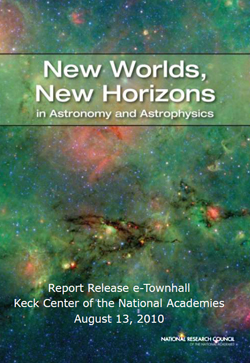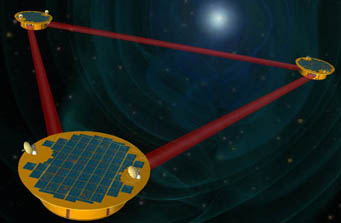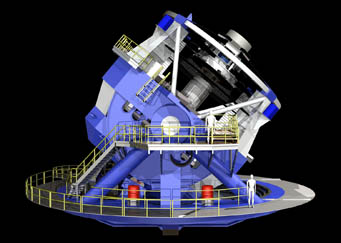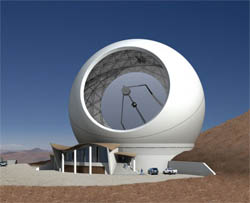For any of you who've agonized about dropping $1,000 or more on a new telescope, consider how much professionals worry about where they'll get money for the seriously expensive toys needed to advance the frontiers of astronomy. To pick just one example, the proposed Thirty Meter Telescope has an estimated price tag of nearly $1 billion. Cutting-edge discoveries don't come cheaply.
So where does the money for such megaprojects come from? Among U.S. agencies, NASA provides the lion's share, about $1.1 billion per year. The National Science Foundation chips another $250 million, though right now much of its "new" money is funding construction of the ALMA radio-telescope array in Chile and the Advanced Technology Solar Telescope (ATST) in Hawaii.

The latest decadal survey of priorities for U.S. astronomy programs was released in August 2010.
National Research Council
OK, then who decides which projects get federal funding? Since the 1960s, that task has fallen to the National Research Council, an arm of the U.S. National Academy of Sciences that periodically assembles a panel of A-list astronomers to assess what projects would get the most bang for the U.S. buck in the coming decade.
It's hard to understate how critical these reviews are the budgeting process. "Nothing is more important to our discipline than the release of the decadal survey recommendations,” says Kevin Marvel, executive officer for the 7,000-member American Astronomical Society. When the one for the 1990s came out, Sky & Telescope devoted nine articles and 54 pages to the conclusions!
Don't worry: I'm not going to write anywhere near that much about Astro2010, the sixth in the NRC's series of astronomy assessments, which debuted last Friday, August 13th. It details a plan of attack for the period 2012-21 — with an eye toward laying the foundation for 2022-31. The massive summary report, written by a 23-member committee chaired by Stanford cosmologist Roger Blandford, has been in the works for nearly two years. All told, 123 experts on nine topical panels sifted through 324 white papers touting various ground- and space-based projects. You can download the full report, New Worlds, New Horizons in Astronomy and Astrophysics, as a free PDF; a printed copy will set you back $39.95 once it's published in final form.
Blandford's charge was to find the best mix of projects to tackle three key scientific objectives: searching for the first stars, galaxies, and black holes; seeking nearby habitable planets; and advancing understanding of the fundamental physics of the universe. As expected, the committee urges strong continued (or increased) support of already-approved programs and basic research. But it also looked at supporting unrealized "honorable mentions" from past decadal assessments.
The winners, if you will, fell into categories with large (exceeding $1 billion), medium ($300 million to $1 billion), and small budgets. Here they are, as ranked in priority by the committee, along with the estimated costs (not all of which may involve U.S. federal funding):
Large-scale space-based efforts:
- Wide-Field Infrared Survey Telescope (WFIRST): an observatory with a 1.5-m mirror, would be placed far from Earth at the L2 Lagrangian point. It would tackle two of the most fundamental questions in astrophysics: Why is the expansion rate of the universe accelerating? And are there other solar systems with worlds like Earth? ($1.6 billion)
- NASA's Explorer Program: a plan to augment the space agency's long-running satellite program, so that modest-cost missions can be developed rapidly to respond to new scientific and technical breakthroughs. ($463 million)

Artist's portrayal of the proposed Laser Interferometer Space Antenna (LISA), which would place a trio of detectors in space to search for gravitational waves.
NASA
- Laser Interferometer Space Antenna (LISA): a low-frequency gravitational-wave observatory, developed jointly by NASA and the European Space Agency, that will open an entirely new window on the cosmos. LISA will measure ripples in space-time caused by exotic sources like white dwarfs and black holes. ($2.4 billion)
- International X-ray Observatory (IXO): a powerful X-ray telescope that will transform our understanding of hot gas associated with stars and galaxies in all evolutionary stages. ($5 billion)

A schematic diagram of the proposed Wide Field Infrared Survey Telescope.
National Research Council
Medium-scale space-based efforts:
- New Worlds Technology Development Program: designed to establish the technical and scientific foundation for a future mission to study Earthlike planets. ($100 to 200 million)
- Inflation Probe Technology Development Program: a program to prepare for a mission to study the cosmic microwave background mission and the epoch of inflation. ($60 to 200 million)
Large-scale ground-based efforts:
- Large Synoptic Survey Telescope (LSST): a wide-field telescope, optimized for variable sources, to address broad questions that range from asteroids and comets that threaten Earth to the nature of dark energy. ($465 million)
- Mid-Scale Innovations Program augmentation: a program designed to provide the capability to respond rapidly to scientific discovery and technical advances with new telescopes and instruments. ($93 to 200 million)
- Giant Segmented Mirror Telescope (GSMT): a large optical and near-infrared telescope that will provide a spectroscopic complement to the James Webb Space Telescope (JWST), the Atacama Large Millimeter Array (ALMA), and LSST. ($1.1 to 1.4 billion)
- Atmospheric ?erenkov Telescope Array (ACTA): permits U.S. participation in an international effort to study very-high-energy gamma rays. ($400 million)

An August 2010 rendering of the Large Synoptic Survey Telescope, which was ranked highest in priority by the NRC's decadal-survey committee.
LSST Corp.
Medium-scale ground-based efforts:
- Cerro Chajnantor Atacama Telescope (CCAT): an 80-foot (25-m) submillimeter telescope that will complement ALMA by undertaking large-scale surveys of dust-enshrouded objects. ($140 million)

The Cerro Chajnantor Atacama Telescope (formerly the Cornell Caltech Atacama Telescope) will survey the sky at submillimeter wavelengths. Its proposed site is 18,400 feet (5,613 m) in elevation, which would make it the highest observatory on Earth.
Cornell Univ.
Add these up, and it totals some $12 billion over 2012-21 time frame. And that doesn't factor in ongoing big-ticket items like the James Webb Space Telescope. Nor does it includes priorities for planetary science and for solar and space physics, the subjects of separate decadal assessments (here and here) under way right now. Unless NASA and the NSF somehow win the federal-budget lottery, many of these programs won't be funded — nor will scores of other worthwhile research efforts that didn't make the committee's cut. There'll be a few winners and plenty of losers.
Of course, setting such priorities — along with making a strong case for supporting astronomical research generally — is the whole point of the exercise. It's a tough job, but I'm glad somebody's doing it.
 0
0
Comments
You must be logged in to post a comment.